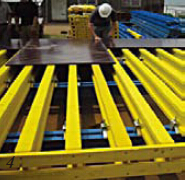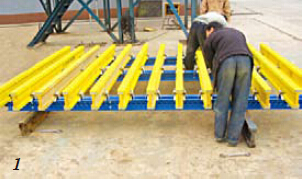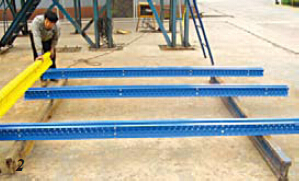Timber-Beam plywood Formwork for Building Construction
- Loading Port:
- Tianjin
- Payment Terms:
- TT OR LC
- Min Order Qty:
- 50 m²
- Supply Capability:
- 1000 m²/month
OKorder Service Pledge
Quality Product, Order Online Tracking, Timely Delivery
OKorder Financial Service
Credit Rating, Credit Services, Credit Purchasing
You Might Also Like
Plywood --- make perfect concrete surface
WISA-Form Birch is a coated special plywood using in the formwork systems where high
requirements are set on the concrete surface and the times of reuses.
With CNBM timber beam & WISA plywood, the formwork is low weight but high load capacity, it is
widely used in construction.
Characteristics:
◆ Component with high standardization.
◆ Assembling in site, flexible application.
◆ Light weight, easy transportation and storage.



- Q:How does steel formwork contribute to the overall structural integrity of the building?
- Steel formwork contributes to the overall structural integrity of the building by providing a strong and durable framework for concrete construction. It ensures accurate and precise alignment of walls, columns, and beams, resulting in a structurally sound and stable building. The steel formwork system is capable of withstanding heavy loads and forces during construction and enhances the overall strength and stability of the structure. Additionally, the use of steel formwork allows for easy and efficient construction, reducing construction time and costs while ensuring high-quality and long-lasting buildings.
- Q:Does steel formwork require any special maintenance?
- To ensure the longevity and performance of steel formwork, special maintenance is required. It is crucial to regularly clean and inspect the formwork surface to remove any dirt, debris, or concrete residue that may accumulate. Depending on the type of contamination, water, mild detergents, or specialized cleaning agents can be used for this purpose. Moreover, it is essential to check for signs of corrosion or damage on the steel formwork. If any corrosion is detected, immediate action should be taken by removing the affected areas and applying an appropriate anti-corrosion treatment. This will help prevent further deterioration and maintain the structural integrity of the formwork. Furthermore, lubrication of moving parts such as hinges and joints is necessary to ensure smooth operation and prevent binding or sticking. Applying grease or oil on these parts will reduce friction and prolong their lifespan. To prevent damage, proper storage of steel formwork is also important. It should be stored in a dry and well-ventilated area, away from corrosive substances. If the formwork is not being used for an extended period, it should be coated with a protective layer such as oil or rust inhibitor to prevent corrosion. Regular inspection and maintenance of steel formwork not only guarantee its durability but also contribute to the safety and quality of construction projects.
- Q:Can steel formwork be used for bridge piers?
- Yes, steel formwork can be used for bridge piers. Steel formwork is a versatile and durable option that is suitable for constructing various types of structures, including bridge piers. It offers numerous advantages such as high strength, ease of assembly and disassembly, and flexibility in design. Steel formwork allows for precise shaping and reinforcement of the bridge piers, ensuring structural integrity and stability. Additionally, steel formwork can withstand the high loads and pressures exerted by the bridge piers during their lifespan. Therefore, steel formwork is a reliable and commonly used choice for constructing bridge piers.
- Q:How does steel formwork affect the overall strength of the structure?
- Steel formwork can greatly affect the overall strength of a structure in a positive way. Steel is known for its exceptional strength and durability, making it an ideal material for formwork. When used in construction, steel formwork provides a rigid framework that supports the weight of the concrete during the pouring and curing process. The use of steel formwork ensures that the concrete is properly contained and supported, preventing any deformation or collapse during the hardening phase. This is crucial for maintaining the structural integrity of the building, as any failure in the formwork can lead to serious consequences. Steel formwork also allows for greater flexibility in design, as it can be easily customized and shaped according to the desired structure. This versatility enables engineers and architects to create complex and innovative designs without compromising the strength of the building. Moreover, steel formwork has a longer lifespan compared to other types of formwork materials, such as wood or plastic. Its durability ensures that the formwork can be reused multiple times, reducing construction costs and minimizing waste. This not only makes it cost-effective but also contributes to sustainability in the construction industry. In summary, steel formwork positively impacts the overall strength of a structure by providing a robust and reliable support system for the concrete. Its strength, durability, and flexibility make it an excellent choice for ensuring the structural integrity and longevity of buildings.
- Q:Are there any weight restrictions for transporting steel formwork?
- Yes, there are weight restrictions for transporting steel formwork. The exact weight limits may vary depending on the specific transportation regulations and guidelines of each country or region. It is advisable to consult with the relevant transportation authorities or logistic companies for accurate information on weight restrictions when transporting steel formwork.
- Q:Can steel formwork be used for both interior and exterior structures?
- Yes, steel formwork can be used for both interior and exterior structures. Steel is a versatile and durable material that can withstand various weather conditions and is suitable for use in both indoor and outdoor environments. It provides excellent strength and stability, making it an ideal choice for constructing structures such as walls, columns, slabs, and beams. Additionally, steel formwork is reusable, which makes it cost-effective and environmentally friendly. Whether it is for interior or exterior construction, steel formwork offers a reliable and efficient solution.
- Q:Can steel formwork be used for dam construction?
- Indeed, dam construction can make effective use of steel formwork. This adaptable and long-lasting alternative is widely employed in a range of construction endeavors, including dams. It boasts various benefits, such as exceptional strength, stiffness, and the capacity to endure the immense pressure and weight of concrete utilized in dam construction. The assembly and disassembly of steel formwork are straightforward, enabling efficient and rapid construction. Moreover, it yields a sleek and consistent surface to the concrete, guaranteeing the durability and longevity of the dam's structure.
- Q:How does steel formwork contribute to the overall efficiency of concrete construction?
- Steel formwork contributes to the overall efficiency of concrete construction by providing a durable and reusable framework for pouring concrete. It offers a high level of accuracy and precision in shaping the concrete, ensuring that the desired dimensions and finishes are achieved. This leads to a reduction in material wastage and labor costs. Additionally, the strength and stability of steel formwork allows for faster construction cycles, enabling projects to be completed on time or ahead of schedule.
- Q:How does steel formwork handle different concrete surface reflectivity?
- Steel formwork is a rigid and durable material that is commonly used in construction for casting concrete structures. When it comes to handling different concrete surface reflectivity, steel formwork can effectively accommodate the variations. The reflectivity of a concrete surface refers to how much light is reflected off its surface. This can vary depending on factors such as the type of concrete mix, finishing techniques, and the presence of aggregates or additives. Steel formwork is designed to be versatile and adaptable, making it suitable for handling different concrete surface reflectivity. One way steel formwork handles varying concrete surface reflectivity is by providing a smooth and consistent surface for the concrete to be poured into. The steel surface is typically pre-treated to ensure it is clean and free from any imperfections that could affect the final finish of the concrete. This smooth surface helps to minimize any irregularities or variations in reflectivity that may occur due to the concrete mix or finishing techniques. Additionally, the rigidity of steel formwork helps to maintain the shape and integrity of the concrete structure during the pouring and curing process. This prevents any deformations or distortions that could impact the reflectivity of the final surface. Steel formwork provides a solid and stable framework that supports the weight of the concrete and allows it to cure evenly, resulting in a consistent reflectivity across the surface. Furthermore, steel formwork can be easily adjusted or modified to accommodate specific requirements for different concrete finishes. For example, if a high reflectivity or polished finish is desired, the steel formwork can be treated or coated to enhance the reflectivity of the concrete surface. Alternatively, if a textured or rough finish is required, the formwork can be designed with appropriate patterns or textures to achieve the desired effect. In conclusion, steel formwork is well-equipped to handle different concrete surface reflectivity. Its smooth and consistent surface, rigidity, and adaptability allow it to provide a stable framework for pouring and curing concrete, resulting in a uniform and controlled reflectivity across the surface.
- Q:Are there any specialized tools or equipment required for steel formwork?
- Specialized tools and equipment are necessary for steel formwork. Some commonly used tools are as follows: 1. To secure the steel formwork panels together and maintain stability and alignment, formwork clamps are utilized. 2. Formwork ties are employed to hold the formwork panels in place and prevent any movement while concrete is being poured and cured. 3. Formwork brackets are utilized to evenly distribute the load and provide support to the formwork panels. 4. Formwork shuttering magnets are utilized to securely hold the formwork panels in place, establishing a strong connection. 5. Formwork jacks are utilized to adjust the height of the formwork panels, enabling precise leveling and alignment. 6. Formwork hangers are employed to suspend the formwork panels from overhead structures, enhancing stability and support. 7. Formwork props are utilized to vertically support the formwork panels, ensuring their position during the concrete pouring process. 8. Formwork vibrators are used to eliminate air bubbles and guarantee proper compaction of the concrete within the formwork. Proper and appropriate use of these specialized tools and equipment is crucial to maintain the structural integrity and quality of the steel formwork.
1. Manufacturer Overview |
|
|---|---|
| Location | |
| Year Established | |
| Annual Output Value | |
| Main Markets | |
| Company Certifications | |
2. Manufacturer Certificates |
|
|---|---|
| a) Certification Name | |
| Range | |
| Reference | |
| Validity Period | |
3. Manufacturer Capability |
|
|---|---|
| a)Trade Capacity | |
| Nearest Port | |
| Export Percentage | |
| No.of Employees in Trade Department | |
| Language Spoken: | |
| b)Factory Information | |
| Factory Size: | |
| No. of Production Lines | |
| Contract Manufacturing | |
| Product Price Range | |
Send your message to us
Timber-Beam plywood Formwork for Building Construction
- Loading Port:
- Tianjin
- Payment Terms:
- TT OR LC
- Min Order Qty:
- 50 m²
- Supply Capability:
- 1000 m²/month
OKorder Service Pledge
Quality Product, Order Online Tracking, Timely Delivery
OKorder Financial Service
Credit Rating, Credit Services, Credit Purchasing
Similar products
New products
Hot products
Related keywords






















